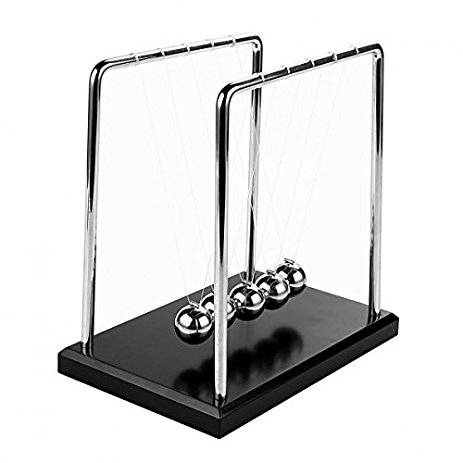Item AP013005: Make observations to produce data to serve as evidence of energy transfer and write an explanation for why balls in a Newton’s cradle eventually stop moving.

The teacher pulls the ball on the left side toward the left and then releases it. Watch the video below to see what happens.
The students notice that the balls slow down and eventually stop swinging. The teacher asks the students to watch the video again and look for evidence that would help them explain why the balls stopped swinging.
1. Watch the video again and pay close attention to the heights of the balls as they swing. How do the heights of the balls change from the moment the teacher let go of the first ball to the end of the video?
2. Watch the video again and pay close attention to the sound produced during the video. What causes the sound to be produced?
3. How did the amount of energy that the balls have change from the moment the teacher let go of the first ball to the end of the video?
4. Write an argument for why the balls stop swinging. Your argument should begin with a claim. Then support your claim with evidence. Your evidence should be based on observations about the height of the balls and sound that you hear. Your argument should end with reasoning that links the evidence to your claim using ideas about energy transfer.
Claim:
Evidence:
Reasoning:
- Percent of Points Earned

- Points Earned
| Avg. Earned | Possible | Percent | |
|---|---|---|---|
| Q1 | 0.46 | 1 | 46% |
| Q2 | 0.72 | 1 | 72% |
| Q3 | 0.51 | 1 | 51% |
| Q4 | 0.94 | 4 | 24% |
- Overall Task Difficulty
| Total Points Earned | Total Points Possible | Total Percent | |
|---|---|---|---|
| 2.63 | 7 | 38% |
n = 237
Note: The total percent is a weighted average based on the total number of points earned divided by the total number of points possible.
- Science and Engineering Practices
- SEP3 Make observations and/or measurements to produce data to serve as the basis for evidence for an explanation of a phenomenon or test a design solution.
SEP6 Apply scientific ideas, principles, and/or evidence to construct, revise and/or use an explanation for realworld phenomena, examples, or events. - Crosscutting Concepts
- CC2 Cause and effect relationships are routinely identified, tested, and used to explain change.
CC5 The transfer of energy can be tracked as energy flows through a designed or natural system. - Disciplinary Core Ideas
- PS3.A Motion energy is properly called kinetic energy; it is proportional to the mass of the moving object and grows with the square of its speed.
PS3.A A system of objects may also contain stored (potential) energy, depending on their relative positions.
PS3.B Energy is present whenever there are moving objects, sound, light, or heat. When objects collide, energy can be transferred from one object to another, thereby changing their motion. In such collisions, some energy is typically also transferred to the surrounding air; as a result, the air gets heated and sound is produced.
PS3.B When the motion energy of an object changes, there is inevitably some other change in energy at the same time.
PS3.C When two objects interact, each one exerts a force on the other that can cause energy to be transferred to or from the object.

